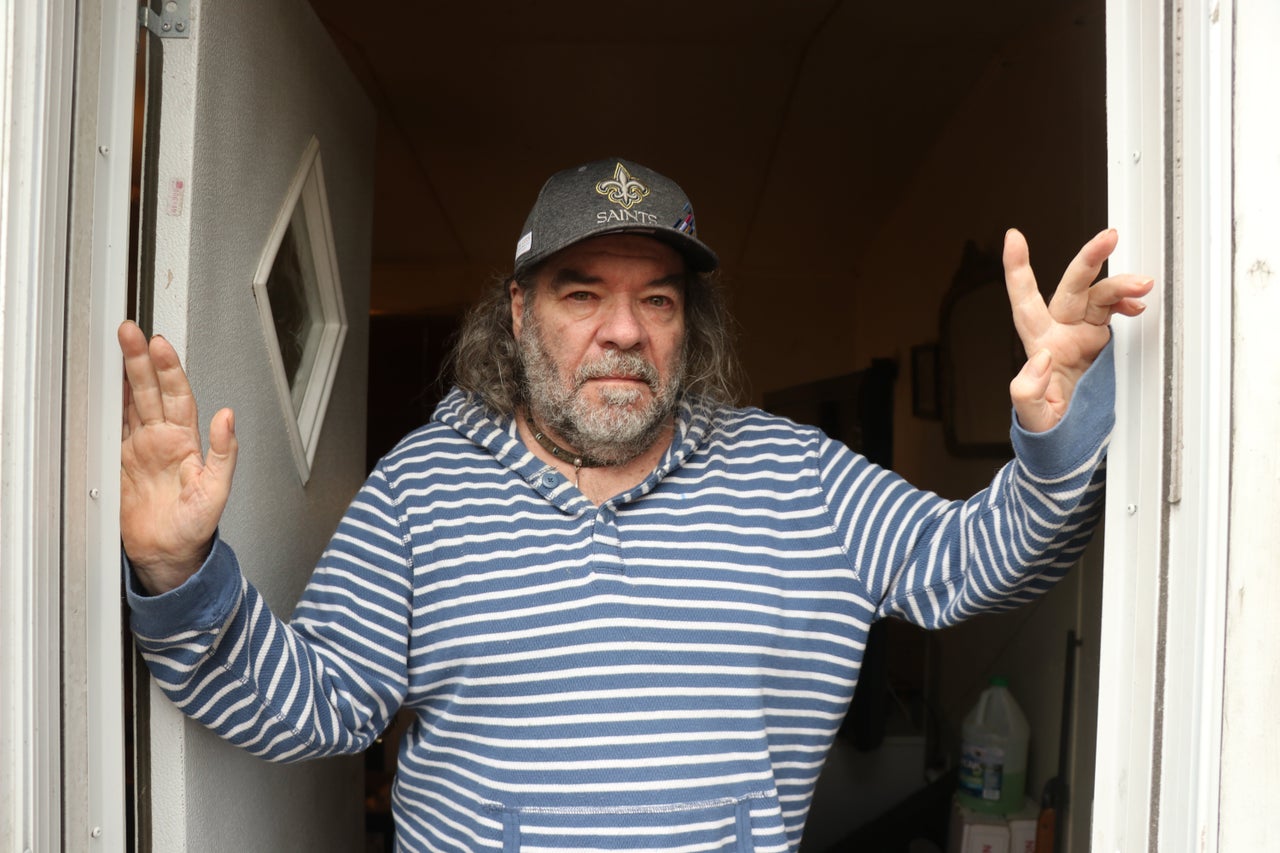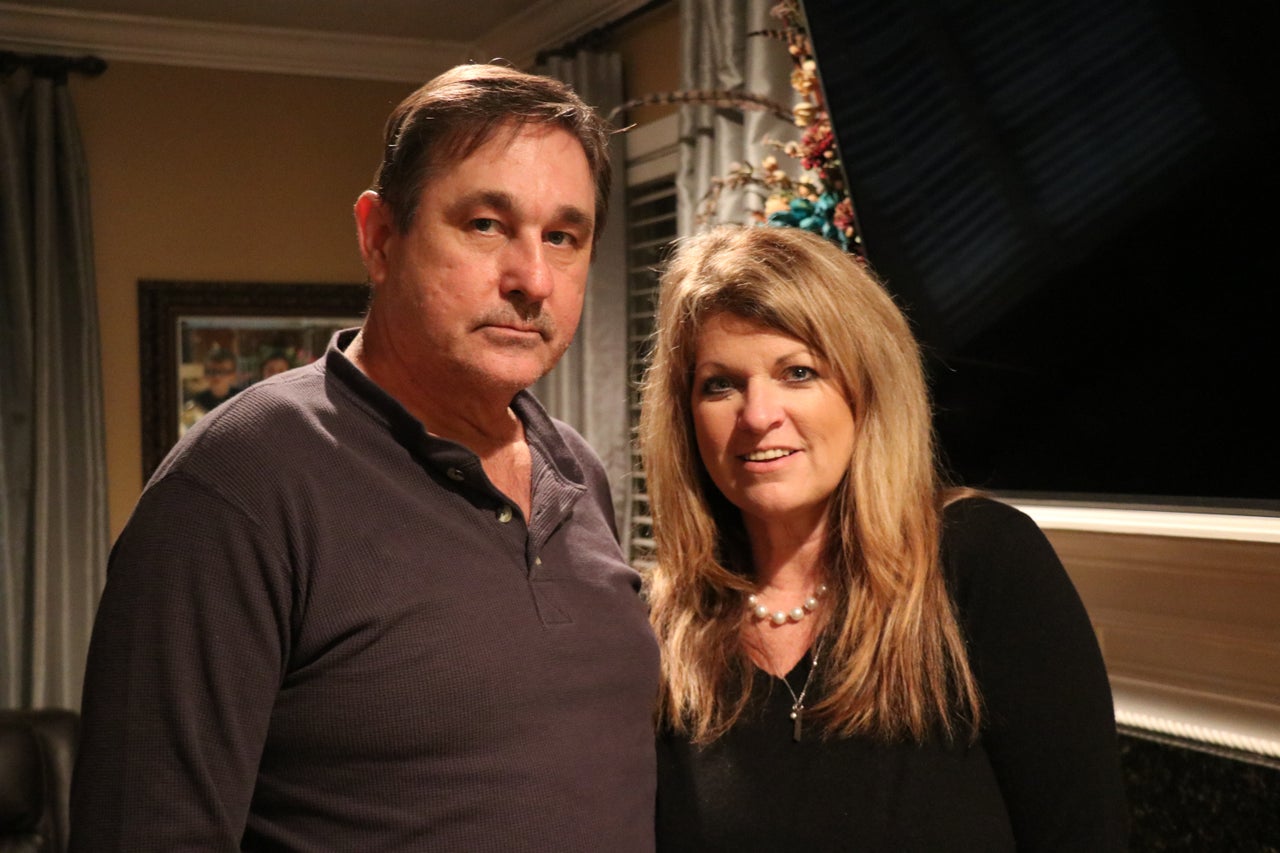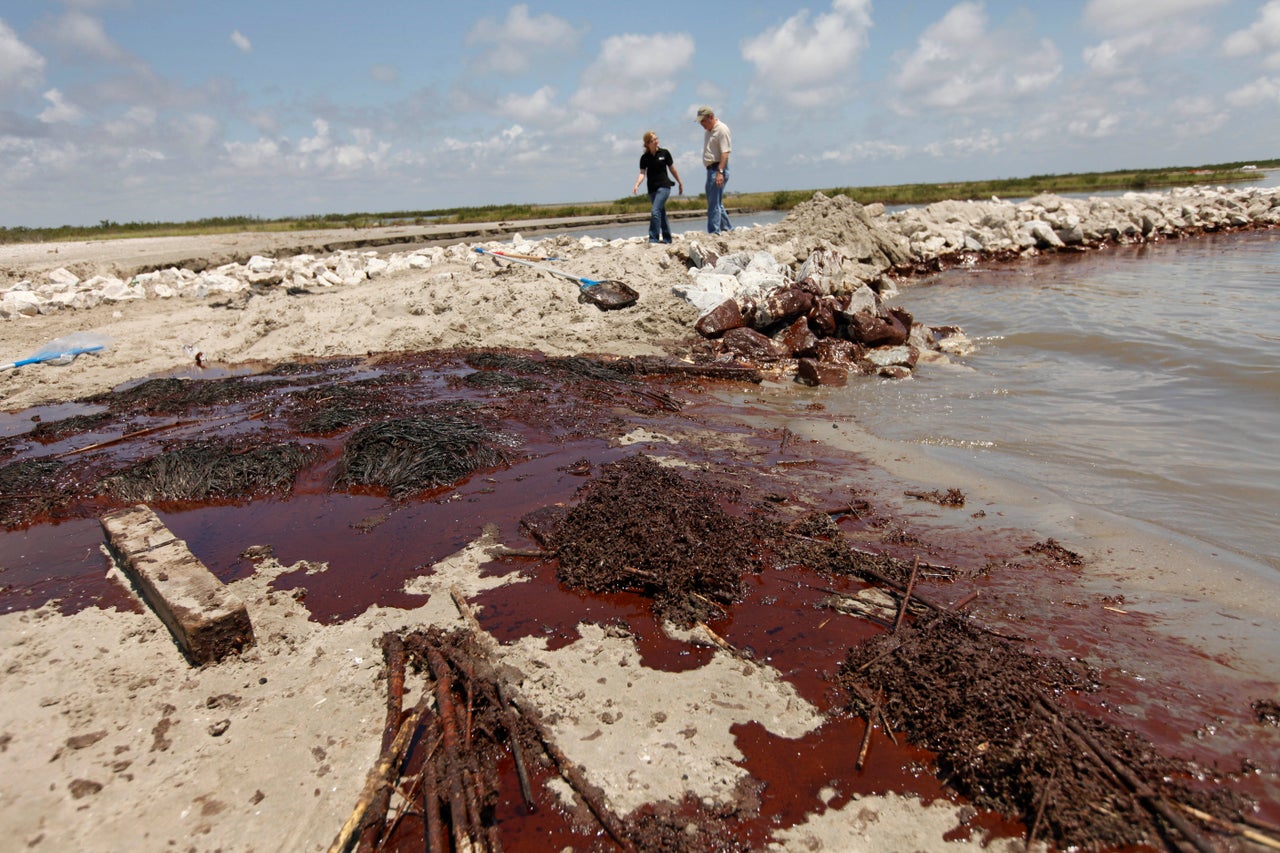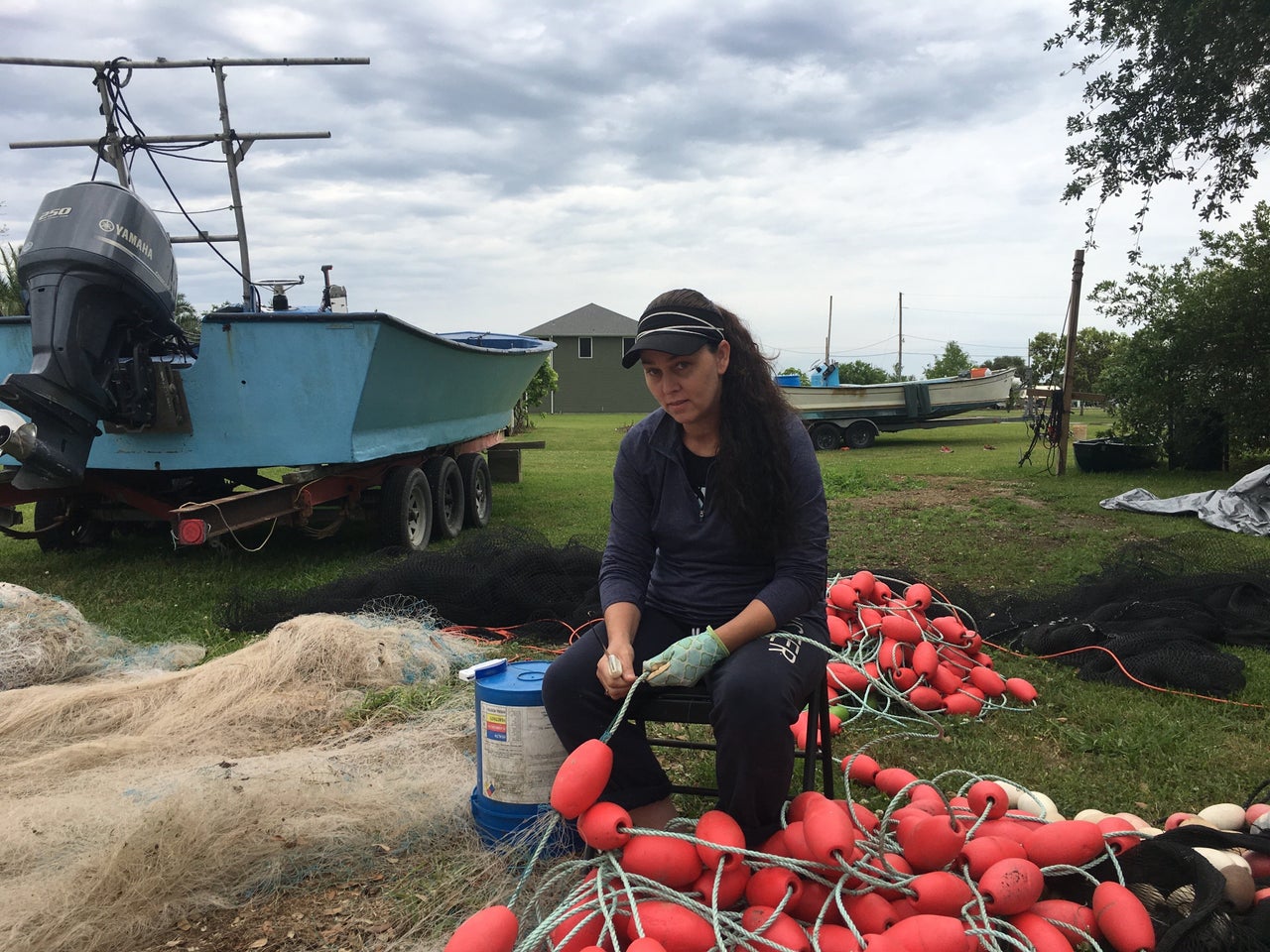Rick DuFour has worked the most dangerous oil cleanup jobs in the Gulf of Mexico. He was there when the Deepwater Horizon oil rig exploded 40 miles off southeastern Louisiana 10 years ago, killing 11 men and spewing more than 200 million gallons of Louisiana crude out of its well a mile below the sea. Much of it poured onto the shores of four states; DuFour was one of the first in line to clean it up.
Over three years, DuFour estimates he worked for 18 different companies, cleaning up a toxic mix of oil and chemical dispersants stuck like peanut butter to the bottoms and bows of ships, picking up oily tar balls on beaches and scraping tar mats as long as football fields from areas they sank just offshore.
There wasn’t a cleanup job he didn’t sign up for, working for weeks on end in the blistering 100-degree heat and humidity, sucking in the noxious fumes that permeated the salt air. He saw hundreds of dolphins wash up dead on the barrier islands where he worked, many of them just babies.
“It was a horrible thing,” he says, squirming uncomfortably in a tattered chair among piles of paper, soda bottles and food wrappers in the battered trailer home that he shares with his stroke-stricken 86-year-old father in Moss Point, Mississippi.
But DuFour, 61, says the worst of all was working at the Ingalls shipyards in Pascagoula, Mississippi, during the summer of 2010. DuFour’s job was to use high-powered hoses that spewed hot water and cleaning agents to wash off the oiled ships and equipment each day. Workers had to suit up in bulky masks and hazmat suits, covering every inch of flesh possible. Sometimes the men had to limit their work to just five minutes out of every hour to avoid heat exhaustion and chemical exposure as the sweat poured off them in buckets.
One day, a company chemist approached the workers with a new compound called Chemical 7248, a special degreaser the Coast Guard now warns should be disposed of as hazardous waste. DuFour says the chemist explained the compound had been “Frankensteined” to clean up the specific type of oil gushing from BP’s well.
He remembers the chief safety officer told the men if they didn’t use the chemical, they could try a hammer and chisel to clean off the toxic gunk, a task no one wanted in the stifling heat.
Soon after spraying the chemical, DuFour says one of the workers started screaming and had to be taken to the hospital. DuFour says the skin on his legs blistered with a “thousand ant bites ... it looked like cherry-colored lipstick went around my eyes and went around my nose and it just burned so bad.” DuFour says he soldiered on, determined to finish the job even as people fell sick around him.

But oil and chemicals finally took a toxic toll. After three years of working oil cleanup jobs across four states, exposed to countless cleaning compounds, oil dispersants and fumes, DuFour collapsed at home one morning in April 2013. He was rushed to the hospital in Ocean Springs, where he remained in recovery for nearly a year.
He was initially diagnosed with a condition similar to Guillain-Barré syndrome, a rare neurological disorder, and he lay mostly paralyzed in a hospital setting during his recovery. He describes the pain coursing through his body like “snakes were crawling up” his legs, torturing him as he was unable to move.
DuFour eventually made it back to his trailer, but the pain never went away. He still can’t move well, and he can barely eat or grasp drinks with partially paralyzed hands. His eyes still burn, too, “like there’s tabasco” in them. A decade after the spill, DuFour is broke, nearly paralyzed and mostly homebound. DuFour ultimately received about $7,700 for the acute medical claim he filed in 2011, one of about 37,000 claims filed against BP in this category.
But his suit to pay for his chronic illness is not expected to go to trial in federal court until later this year. He hopes it will allow him to get enough money to get extensive physical therapy, something he estimates could cost over $1 million a year.
DuFour’s dream is to get enough money to get his dad “squared away” with a new home and better care, and maybe try his hand at gold prospecting in nearby Alabama. “There are so many things that I haven’t done that I still want to do.”
His lawyer, Craig Downs, represents about 3,000 individuals across the Gulf who have filed medical cases against BP. He says DuFour’s case is one of the worst he has seen. Nearly all of the thousands of chronic medical cases filed across the Gulf have yet to go to trial due to a complicated oil spill legal structure that focused on paying financial claims first. The chronic medical cases are slowly winding their way through the judicial system, but experts say there’s no guarantee they’ll turn out well for plaintiffs like DuFour who have racked up expensive medical bills.
“It’s a tragic story,” Downs says. “The oil industry as a whole doesn’t want people to know how dangerous oil spills are. They don’t just kill animals. And we’re just starting to see a rise in cancers now.”
Cancer is associated with oil spills, but but researchers say more detailed studies should be done to confirm the links. Downs says his team of scientists believe the cancer links can be proven. His firm already has about 300 oil-spill-related cancer cases, which he thinks ultimately will rise dramatically. “The cancer rates will get much worse.”
BP did not respond to a request for comment for this story.
‘This Dispersant Will Eat Your Skin Up’

About 20 miles east of Dufour’s trailer, Rocky Meadows, a former real estate appraiser, struggles with chronic neurological, skin and memory problems he blames on the oil spill.
Meadows, 60, lives with his wife in a comfortable ranch-style home in Ocean Springs, less than a mile from the Mississippi shore. He says there were numerous times that the smell of burning smoke and chemical fumes made him dizzy and sick to his stomach. His neighbors reported seeing large transport planes dumping oil dispersants on the coastal areas close to shore, even though the Coast Guard prohibited it at the time.
Meadows says he and his father-in-law were doused with dispersants from planes flying over their boat one day that summer, trying to repair a rope-ensnared propeller. His father-in-law developed kidney disease soon afterward and died in 2013. Meadows thinks his father-in-law is one of the many victims of the BP spill never counted in any official tally.
The former high school star athlete’s own health has deteriorated as well. His skin sometimes itches and burns; he takes scalding hot baths to avoid scratching himself until he bleeds. He’s still extremely forgetful, unable to remember sentences he utters moments before.
Meadows says it took him seven years to get disability payments from the state. He hired a lawyer who he thought would get him millions in compensation from BP. Instead, he says, they got about $60,000 after taxes, which didn’t come close to covering his medical bills.
Finally, his wife, Becky, quit her job as a teacher to take care of him. They now live month-to-month on his disability checks. “Before the spill, everything we owned was paid for ― the house, the land ― and we had money in the bank and the stock market,” Meadows says in a strong Mississippi drawl. “We went from that to where we could hardly pay the light bill.”
Meadows is still seeing doctors, but he’s unsure he’ll ever get any sort of permanent relief, nor any additional financial help from BP. “The oil companies are big,” he says, “nobody don’t want to go against them.”
James “Catfish” Miller, 55, is living a similar nightmare near the coastal Mississippi town of Pass Christian. A hardscrabble fisherman who’s worked shrimp and oyster fisheries all his life, Miller was eager to sign up for the Vessels of Opportunity Program that BP assembled to clean up the oily mess that flowed like a volcano from the busted Deepwater Horizon well.
Early in the summer of 2010, as rivers of oil floated toward the Mississippi barrier islands and shore, Miller was out on his fishing boat with his crew working on the oil cleanup. Miller says he noticed a bunch of small skiffs approaching with cleanup workers decked out in Tyvek protective gear in masks and gloves. They looked like “they just stepped off a UFO,” he recalls.
When Miller asked them why they wore the suits, he was told “Man, don’t you know? This dispersant will eat your skin up. It’ll cause cancer.” Miller says he and his crew had no protective gear or hazmat training at the time. Soon, the skiffs were shooting streams of liquid chemical dispersant from hoses at oil patches 100 feet away. “It cut like a knife,” Miller said, and made the “oil disappear in front of us like candy.”
Miller said his skin started tingling and burning. “It made our eyes dry up in our sockets … I passed out here on the floor,” he said. Everyone on his boat, he said, was “delirious.” Miller said Coast Guard personnel were in the area, but did nothing to intervene.
Miller says his crew ended up in a Biloxi hospital for three days, sick and vomiting, with chemical boils popping up on their skin and high levels of heavy metals in their bloodstreams. Miller says only later were they given any protective gear or hazmat training.

Miller is still sick, and unable to work most days. By his estimate, he’s spent over $750,000 on medical bills. Miller said his marriage ended when his wife grew tired of taking care of him and couldn’t handle his mood swings, diagnosed as symptoms of PTSD.
“I was mad at the world,” he recalls. “I was ready to hang myself.”
Despite numerous tries, Miller has not been able to get disability payments from the state, and the lucrative BP money he made on the Vehicles of Opportunity Program has quickly drained. Miller was forced to go back to work fishing, but the fisheries were damaged from the spill, and he was still sick and could only work about 20 days on average each year. Last year, Mississippi river flooding and toxic algal blooms wiped out fisheries across the state, ruining his livelihood again.
Broke and despondent, Miller has filed a medical claim against BP with the federal court in New Orleans, but he says he’s not holding his breath. He knows he’s in line with a lot of other sick people, cleanup workers and fishermen who have been down the same tortuous road he’s been.
“BP has devastated my life, it really has. I don’t need a shoulder to cry on, but look what it’s done to my life,” he said. “I’m still going through it.”
‘We Were Expendable’
Dr. Michael Robichaux, an ear, nose and throat specialist in Raceland, Louisiana, has treated Miller and more than 100 patients exposed to the oil spill.
The former Louisiana state senator believes his patients’ symptoms ― memory loss, fatigue and neurological disorders ― are connected to the toxic properties of Corexit, the nearly 2 million gallons of powerful oil dispersant that BP used in record amounts to break up the oil at the well site and knock it down from the ocean surface to keep it from getting ashore.
“We need to be a lot more careful about what we put out there. We need to take a scientific view, not an industry-response view,” said Robichaux. “I think it’s been established that Corexit is a hazardous material and we need to get it off the oil field contingency plan.”
Miller is one of 20 people affected by the spill included in a new Government Accountability Project report. The whistleblower organization has closely followed the health problems of dozens of workers and residents in the Gulf related to the use of the chemical dispersant Corexit. “Consistently the symptoms are not going away, and frequently they are getting worse over time,” said GAP Legal Director Tom Devine. “This is a nightmare that Corexit victims cannot wake up from.”
Marine toxicologist Riki Ott, a veteran of the Exxon Valdez and BP spills, has been trying to get the government to take Corexit and other dispersants off the market for years. Her advocacy group, Alert, filed a lawsuit in federal court in January to force the U.S. Environmental Protection Agency to quickly update its plans to combat oil spills.
Recent Coast Guard and National Institutes of Health studies have also linked Corexit to health problems, and it’s been shown to make oil many times more toxic to marine life. Critics say the EPA has dragged its feet on updating federal rules; the agency now says new oil spill response rules won’t be in place until at least 2021.
“We need this-century technology written into the National Contingency Plan,” Ott says. “Politics and science, like oil and dispersants, is not straightforward.”

For Plaquemines Parish, Louisiana, fisherman Kindra Arnesen, whose entire family suffered health problems during and after the spill, the failure to protect human health is the most egregious failure of the government’s response to the historic blowout.
Arnesen, a board member of the Louisiana Shrimp Association, has spent 10 years fighting with local, state and federal agencies for information and assistance to help her damaged fishing community of lower Plaquemines, which she believes still suffers from an excess of chronic disease and deaths related to the spill. Some days, Arnesen says she doesn’t know whether to cook dinner or attend a funeral.
“I don’t know that I want my address to have the name Louisiana anymore,” Arnesen says, sitting in the comfortable kitchen of her Buras, Louisiana, home, rebuilt after it was destroyed by Hurricane Katrina 15 years ago. “We were the sacrifice zone, and everybody here is a tradeoff. So that’s a hard pill to swallow, but that’s what I’ve learned ... we were expendable.”
Dr. Dale Sandler, a senior investigator with the National Institute of Environmental Health Sciences and director of a major federal health study of BP spill workers, says there is still a lot of work to do to identify specific health problems linked to the blowout.
The $25 million observation of 32,000 cleanup workers has revealed a variety of health problems linked to the oil spill, including damages to lung function, increase in heart disease, neurological and skin diseases, and serious mental health disorders. Other Gulf studies have even shown links between oil exposure and risk of liver and lung cancer.
Even though one of their studies found respiratory health problems connected to the use of Corexit, Sandler believes there has been an “outsized fear” of dispersants that her studies largely have been unable to verify. Official records of dispersant use often don’t match areas where people complained of health problems, she says, and without real, on-the-ground data, connecting the dots is difficult.
But some experts say the official data on exactly how much dispersant was used and where is suspect. Ira Leifer, a scientist with the Marine Science Institute at University of California, Santa Barbara, worked with NASA and the U.S. Coast Guard to study plumes of toxic compounds in the early days of the BP spill.
Leifer believes the official levels of the use of dispersant may have been undercounted, pointing to documents unearthed in 2010 that showed the true amounts of dispersants used were actually 10 times the official amount reported to the Coast Guard.
“There likely was a significant underreporting of the use of dispersants,” Leifer says, something that many cleanup workers and coastal residents also believe. “This suggests the effects were a lot higher.”
The NIEHS study is ongoing, including plans to track incidences of cancer, which are likely to start showing up now in state registries, Sandler says. She agrees too little has been done to help people with medical problems, especially for workers and residents who don’t have access to decent medical care or health insurance.
“In an oil spill disaster, it’s all about protecting the shore, not the people,” Sandler says. “There are no systems in place to track the health impacts of people. We need the resources to build the infrastructure to make that happen next time.”
